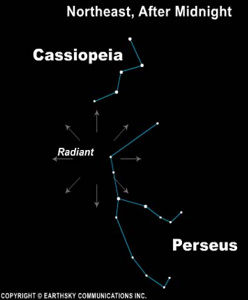
© n/a
The Perseid meteor shower is an annual meteor shower that is extremely regular in its timing and can potentially be visible for weeks in the late summer sky, depending on weather and location.
The Perseid meteor shower is named after the constellation Perseus, which is located in roughly the same point of the night sky where the Perseid meteor shower appears to originate from. This is a useful naming convention, but not very accurate!
The source of the Perseid meteor shower is actually debris from the comet Swift-Tuttle. Every year, the earth passes through the debris cloud left by the comet when the earth's atmosphere is bombarded by what is popularly known as "falling stars."
When and where to look for Perseids in 2011In 2011, visibility (the weather also notwithstanding) will be somewhat limited by a full moon on August 13 which will likely wipe out fainter meteors from view.
Because of the way the earth hits this debris cloud, the Perseid meteor shower is much more visible in the Northern hemisphere.
People in Canada, for instance, can see the meteor shower by mid-July, but generally there isn't much activity at such an early date. Throughout Europe, the US and the rest of North America, meteor shower activity usually peaks sometime around August 12th, when it is not unusual to see at least 60 meteors per hour streaking across the Northeast sky.
The meteors are certainly bright, but they are actually only tiny objects, usually no more than a grain of sand. However, as they travel at speeds of up to 71 kilometers per second, these small particles put on quite a brilliant show.
The Perseid meteor showers were observed as far back as two thousand years ago, and in ancient Europe, the Perseid meteor shower was known as the "Tears of St. Lawrence."
How to view PerseidsToday, the best place to observe the Perseid meteor shower (or any meteor shower for that matter), is somewhere dark, away from light pollution, and with the moon out of the field of vision. The less light visible, the more brilliant the meteor shower will be.
Telescope or camera?While mostly viewable to the naked eye, the annual Perseid meteor show may be partially obstructed by the moon, clouds or night mist, so amateur astronomers may want to carry along a pair of binoculars or a camera with a telescopic lens. Even on clear nights, some kind of viewing aid comes in handy for catching sight of even the faintest of falling stars, aptly named "telescopic" meteors. Experts usually just advise to forget the telescope, and simply look up toward the northeast sky.
For photographing the annual event, a digital camera mounted on a tripod helps to steady the images that swiftly move across the sky. A quick trigger finger also helps. Even random clicks during the height of Perseid "prime-time" will guarantee that you'll catch something! Be sure to have the camera focused on infinity and, if your camera permits, leave the shutter open for several minutes for the most spectacular photographic effects.
More about Perseid meteor showers around the Web:Meteor Showers & Viewing Tips - The full year's schedule with peak dates and best viewing times in the U.S.
2009 Perseid meteor shower photos - Dozens of photos from the 2009 Perseids with related photo tips and how to's on photographing meteor showers.
How to View the Perseid Meteor Showers - Step-by-step guide from eHow.com with advice on where, when and how to view the annual meteor display, with visitor comments and related resources.
Meteors: A Primer - Brief but informative overview of common terms that help identify various sizes and types of meteors.
Reader Comments
to our Newsletter